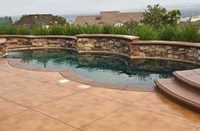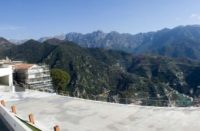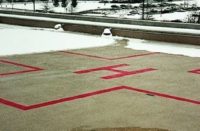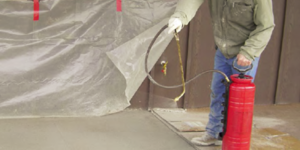 We all know that the weather plays a huge factor in our trade. Trying to figure out the ever-changing weather conditions and how they affect our work is the lifelong journey of every dedicated concrete installer. As we all know, weather can change in a very short period of time despite what the weatherman calls for on TV. A few years ago, I found a material that works like a secret weapon in certain weather conditions. It is called an evaporation reducer and it does exactly what its name suggests.
We all know that the weather plays a huge factor in our trade. Trying to figure out the ever-changing weather conditions and how they affect our work is the lifelong journey of every dedicated concrete installer. As we all know, weather can change in a very short period of time despite what the weatherman calls for on TV. A few years ago, I found a material that works like a secret weapon in certain weather conditions. It is called an evaporation reducer and it does exactly what its name suggests.
Did you ever do a pour in spring or late fall when the ground is cool, and the sun real strong? The cool ground kinda makes the concrete mushy on the bottom, yet the surface is setting up fast from the sun. Now throw in a little wind, and you have yourself a royal headache brewing, trying to figure out what the heck is going on with the concrete. So you ask yourself, how do I finish this…? Surface evaporation can be a major pain in the butt with everyday standard concrete, then when you add some color hardener that will rob away a bit more moisture, it adds fuel to the fire — now your concrete is doing everything you don’t want! Days like this you’re thinking about having to rip it out, even before it is fully set or anywhere close to being finished, mainly because when the effects of nature have dried out the surface, finishing the slab could be a real challenge. Evaporation reducers are great in this kind of situation, although they are good for many other climatic conditions as well. The trick is to know when to use an evaporation reducer and to use it early in the game.
An evaporation reducer is not a finishing aid and should not be used in the final finishing operations after all other efforts have failed. This type of product should be used immediately after screeding, and/or between floating operations in the early stages of the pour. This material is made by several different manufacturers; they all produce the material with a fugitive dye in it so you can see where it is applied and where it is not applied. I have seen it in yellow, blue and pink. It comes as a concentrate that is diluted nine parts water to 1 part evaporation reducer, which yields 10 gallon of material. Coverage will be between 2,000 and 4,000 square feet. This is dependent on the volume rate at which the material is applied. It is usually applied with a hand-held pump sprayer.
Evaporation reducer works by forming a mono-molecular film on the surface of the fresh concrete. This film holds the moisture content in the fresh concrete while it is in its fresh or plastic state. Additionally, it reduces surface moisture evaporation by about 80 percent in the wind and about 40 percent in direct sunlight; it eliminates or greatly reduces plastic-shrinkage cracking and crusting from the wind; and it helps greatly with excessive evaporation caused by portable heating in winter months.
It is also wonderful with sun spots coming through large windows and when half the pour is in the sun and half the pour has shade. The fluorescent color tints disappear completely upon the drying of the concrete and any remaining residue does not alter the final color or impair bonding of sealers.
This is one item that will help improve the quality of your final work, even if weather is against you. Good luck on all your projects!
-Bart Sacco, Concrete Texturing Tool & Supply, Throop, Penn.













